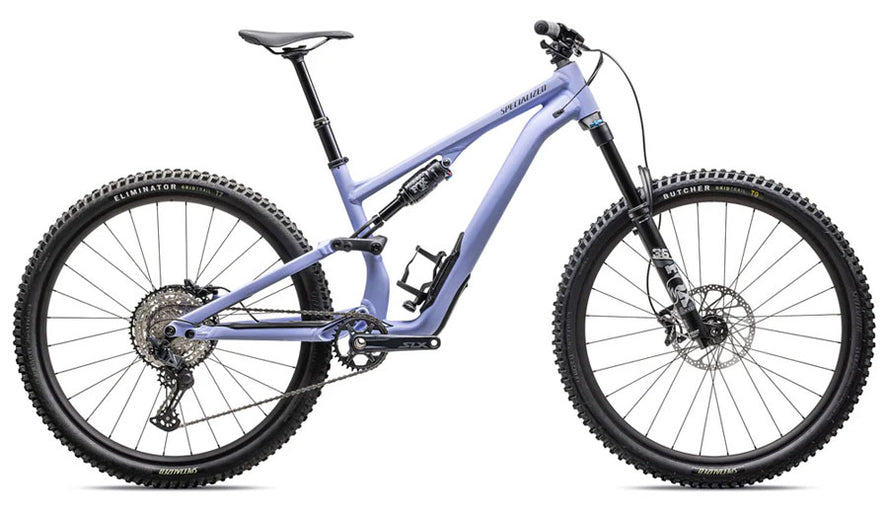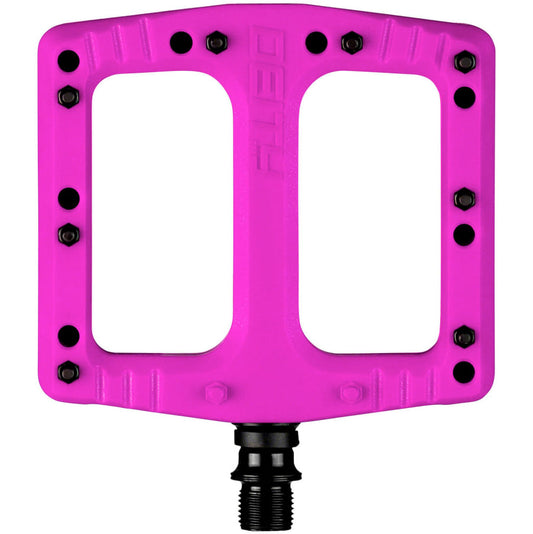INTRODUCTION
Whether you're new to mountain biking or a seasoned off-road trailblazer, you're in the right place. Our top picks highlight the best mountain bikes in a variety of styles, so you can be sure you'll find the perfect MTB for you. Need more guidance? Check out our post on How to Choose a Mountain Bike for five additional questions to answer before purchasing your new MTB.
Don’t let the term “mountain biking” intimidate you! Not all mountain biking is done in the mountains, as each year more and more MTB trails are built with all levels of rider in mind. Visit a trail in your area and you’ll see everyone from little kids on balance bikes to extreme riders on downhill bikes. From tight and twisty singletrack to more leisurely rides, these trails are for everyone! Regardless of your riding ability, now is a great time to get into mountain biking. So take a look at our top picks and see which bike is best for you.
Specialized Rockhopper Expert
Proving that true trail-taming capability doesn’t have to come at an intimidating price—the Rockhopper Expert is the culmination of 30 years of redefining the relationship between value and performance. The Rockhopper’s butted aluminum frame features hydroformed top and downtubes to keep weight low and strength high, all while providing increased standover clearance, slick internal cable routing, and dropper-post compatibility.

Specialized Stumpjumper 15 Comp Alloy
In 1981, Specialized launched the Stumpjumper family of mountain bikes, bringing the sport of mountain biking to the masses and introducing many to the world of off-road riding. The Stumpjumper 15 Comp Alloy might be the most versatile member of the Stumpjumper family. This full-suspension MTB devours bumps, feels playful and easy to control, and allows you to customize the ride to fit your needs. The comfortable geometry puts you in control, optimizing traction and handling around corners. For an ideal blend of fun and capability, you can't do much better than the Stumpjumper 15 Comp Alloy.

Specialized Epic 8 Expert
This full-suspension mountain bike is a cross-country monster, able to tackle the most rugged trails through an innovative blend of high-powered capability, efficiency, and lightweight construction. It's the most capable 120mm bike on the planet, with advanced shock absorption to eat up the biggest bumps. The SRAM 4-piston brakes feature trail-ready stopping power in a race-ready system, and Specialized's unique SWAT downtube storage makes it easy to bring snacks, clothing layers, and other MTB essentials. Whether it's race day or time for a leisurely weekend ride, the Epic 8 Expert handles it all in rugged style.

MOUNTAIN BIKE FAQS
HOW DO I CHOOSE A MOUNTAIN BIKE STYLE?
There are two important questions you need to ask yourself before you choose a mountain bike: What terrain do I plan to ride, and what is my riding style? There are a lot of options, and each model has characteristics that suit a specific terrain and style of riding. Are your favorite trails relatively flat and rolling, or are there steep climbs and descents? Do you tend to be more aggressive or conservative in your riding? Do you plan to get out and enjoy the trails, or is your calendar already filling up with races? During what time(s) of the year will you be riding? These are all questions that will help you find the perfect fit, but the best way to decide is to visit your local ERIK'S and test-ride some options.
WHAT ARE THE SUSPENSION OPTIONS ON A MOUNTAIN BIKE?
Mountain bikes come in three suspension styles, which impact what type of terrain the bike will excel at.
Rigid mountain bikes: A rigid mountain bike has no suspension. These bikes are not as common anymore, but they are the grandfathers of mountain bikes. The original Specialized Stumpjumper, the first major production mountain bike, had no suspension. Most fat bikes fall into this category. True rigid mountain bikes are for the purist looking for the simplicity of no suspension.
Hardtail mountain bikes: A hardtail mountain bike has a suspension fork but no suspension in the rear. By adding front suspension to the bike, you allow it to flow through rougher terrain faster and with more control, making the ride more comfortable. This setup is most commonly found on cross-country bikes as they're lighter than their full-suspension brethren; entry to mid-level bikes are also often hardtail, as they’re less expensive than full-suspension bikes. With larger tire size options, there are some great hardtail bikes that are capable of tackling very technical terrain.
Full-suspension mountain bikes: As the name implies, a full-suspension bike has suspension in the front and rear. Full suspension allows the bike to tackle rough terrain with ease, providing more control, speed, and comfort to the rider. Full-suspension setups are found on many different types of mountain bikes, with shorter to longer travel (i.e., the amount of vertical movement the suspension system allows) depending on the bike's intended use.
ARE FULL-SUSPENSION BIKES SLOWER?
No! It's a common misconception that having suspension in the rear will make your bike slower or less efficient. This has been proven untrue. Suspension helps you get over obstacles by absorbing impacts that would normally slow you down and allows you to flow over the terrain smoother and faster.
WHAT ARE THE DIFFERENT FRAME MATERIALS IN A MOUNTAIN BIKE?
The first thing to remember about frame materials is that they're only as good as the engineering behind them. You can find great (and poor) mountain bikes made from any of these materials.
Carbon fiber is an excellent frame material for two main reasons. First, it has incredibly high strength- and stiffness-to-weight ratios. Second, unlike steel or aluminum, it can be manipulated in almost endless ways. This means a frame can be incredibly stiff in specific areas or directions, like those that translate pedal power into forward momentum. It also means a frame can have forgiveness in other areas to reduce trail vibrations and impacts.
Aluminum has a better strength-to-weight ratio than steel. This allows manufacturers to manipulate tube shapes more than they can with steel, resulting in remarkably strong yet lightweight bicycles that still have great ride qualities in terms of efficiency and comfort.
Steel has a high strength and durability rating, and its properties generally yield a very comfortable-riding bike. Of the three materials listed here, it’s also the heaviest, which is why you don’t find as many mountain bikes made from steel today.
WHAT ARE THE DIFFERENT COMPONENTS ON MOUNTAIN BIKES?
While there are nearly endless ways a mountain bike could be configured and many different setups in terms of the parts you find on a frame, the good news is that manufacturers put a lot of thought into what components work for different riding styles.
Regarding gears, today you’ll likely find 12, 11, 10, or 9-speed cassettes (the gears on the rear wheel) and one or two chainrings. Though there might seem like a dizzying number of setups available, bikes will come with the gearing setup to match the style of riding the bike is designed for.
As you move up in levels of components and wheels, you’ll see a common theme: lower weight and higher performance. Regarding shifting, this will mean faster, crisper shifts. At the top end, you’ll even move from mechanical to electronic shifting, which offers the pinnacle of performance. Top-end bikes feature carbon rims that are incredibly strong but also remarkably light.
WHAT BRAKE OPTIONS DO MOUNTAIN BIKES HAVE?
Almost all mountain bikes today have disc brakes. Disc brakes have some major advantages. First and most importantly, they offer better and more controlled stopping ability in a variety of conditions. So, whether the trail is dry and dusty, wet and muddy, or covered in snow, you’ll have the braking performance you need. Disc brakes also allow the rider to apply braking power more accurately, which means you’re less likely to apply too much power and skid, losing traction, control, and braking performance. A final advantage is that disc brakes allow for wider tire and rim options. Without disc brakes, we probably wouldn’t have fat bikes or other wide tire options.
Disc brakes come in two variations: hydraulic and mechanical. This refers to what kind of power converts your pull of the brake lever to moving the brake pads. Hydraulic brakes use a fluid that travels between the braking lever and pads. They have a very smooth, precise motion and are less susceptible to the elements as they’re a closed system. Mechanical disc brakes use a cable, much like a traditional rim brake, and are less expensive than a hydraulic setup.
WHAT ARE THE DIFFERENT MOUNTAIN BIKE WHEEL SIZES?
First, let’s clear up some confusion. The name of the wheel size isn’t actually the size of the wheel (stick with us). The wheel size name is instead an approximate measurement of the diameter of the tire, not the wheel. This started with the original 26” mountain bike wheel size and has stuck with us since. Now, on to the actual sizes.
26 Inch: It wasn’t long ago that mountain bikes came with one wheel size, which was 26”. This wheel size is still available but is far less common now. It is, however, the standard wheel size for fat bikes.
27.5 Inch (aka 650b): Situated between the 26” and 29er size is the 27.5” wheel. This size has become popular because it rolls over terrain better than a 26” but provides more maneuverability and faster acceleration than a 29er. The 27.5” wheel size is now found on all types of mountain bikes for nearly all kinds of riding.
27.5+: A 27.5+ wheel also has an approximate tire diameter of 27.5” and has similar handling to the 27.5" wheel. The "+" refers to the width. These tires are typically 2.6” inches wide or more, which is why bikes with these tires are typically called fat bikes. The increased tire volume means the tire can be run at a lower pressure. This provides for incredible traction on all sorts of technical terrain and obstacles. The high volume and lower pressure also give the rider a more comfortable ride as the tire absorbs all sorts of impacts.
29er: 29er is the common name for the 29” wheel. This size is excellent for rolling over obstacles, and it holds its speed very well, making it very popular on cross-country bikes.
-
 TRY IT NOW
TRY IT NOWStop Searching, Start Riding!
-
 SHOP NOW
SHOP NOWFor Technical Trials, Flow Trails & Everything Else
TOP MOUNTAIN BIKE ACCESSORIES Shop All
About ERIK’S
Erik was only 13 when he started ERIK'S in 1977. His first bike, a hand-me-down from an older family member, sparked his interest in bikes. With entrepreneurial spirit, and the money he saved from his job as a paperboy, Erik began his business. ERIK’S Bike Board Ski has grown into the Midwest’s leading bike, snowboard & downhill ski retailer. We are passionate about our sports & experts on all the gear we carry! Learn more about ERIK’S History.















